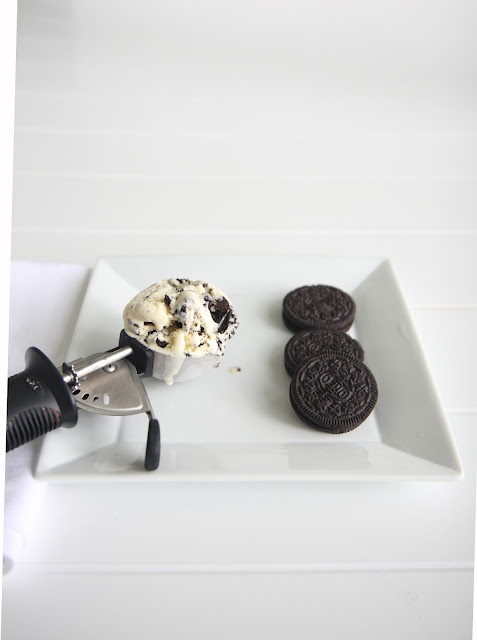Šiuo receptu tikrai
nesitikiu ką nors nustebinti; juo
labiau kad šitą patį receptą, tiek kiek kitokiuose pavidaluose jau
esu publikavusi bent porą kartų (vaniliniai ledai su avietėmis ir su greipfrutu šerbetu). Šie ledai yra patys paprasčiausi, įprastiniai, vaniliniai, tik į juos dar pritrupinta banalių krautuvinių sausainių.
Man patinka tai, kas paprasta, be
jokios ten rafinerijos; ir skoniai
paprasti man patinka; ir aš labai mėgstu Oreo
sausainius; ir dar mėgstu cookies and
cream ledus. Todėl pasikartodama vėl rašau pačių buitiškiausių ledų receptą.
Jeigu kartais turėsite ūpo, patariu ir jums nusipirkti Oreo sausainių; jie man labai skanūs ne tik leduose, bet ir paprasčiausiai su stikline šalto pieno. Sutinku, kad tuose sausainiuose nėra nieko nepaprasto; bet ar paprasta nėra gerai? Man paprasta visada yra gerai; kuo paprasčiau, tuo geriau. Paprasta yra tai kas įprasta, nuspėjama, aišku. Paprastumas man yra dižiulė vertybė, tiek maiste, tiek bendrai – gyvenime.
Jeigu kartais turėsite ūpo, patariu ir jums nusipirkti Oreo sausainių; jie man labai skanūs ne tik leduose, bet ir paprasčiausiai su stikline šalto pieno. Sutinku, kad tuose sausainiuose nėra nieko nepaprasto; bet ar paprasta nėra gerai? Man paprasta visada yra gerai; kuo paprasčiau, tuo geriau. Paprasta yra tai kas įprasta, nuspėjama, aišku. Paprastumas man yra dižiulė vertybė, tiek maiste, tiek bendrai – gyvenime.
Aušra

Ledai su Oreo sausainiais
1 stiklinė* pieno
2/3 stiklinės cukraus
žiupsnelis druskos
1 1/2 stiklinės riebios grietinėlės
5 kiaušinių tryniai
1 arbatinis šaukštelis vanilės
ekstrakto
16 Oreo sausainių
*1 stiklinė = 236 ml
Ledų gaminimo mašinos šaldomą kibirėlį
ir mentelę įstatyti į šaldiklį, kad gerai įšaltų, mažiausiai 24 valandoms.
Į šaldiklį taip pat įstatyti 1,5 L talpos
sandariai užsidengiantį indą, kad ir jis gerai įšaltų.
Į didoką dubenį supilti
grietinėlę.
Vidutinio dydžio dubenyje išplakti
trynius.
Nedideliame puode ant vidutinės ugnies kaitinti pieną, cukrų ir
druską, laikas nuo laiko pamaišant, kol pradės kilti garai. Puodą nukelti nuo ugnies; karštą mišinį plona srovele pilti į trynius, viską pastoviai ir intensyviai plakant
šluotele.
Supylus visą pieną, trynių ir pieno
mišinį perpilti atgal į tą patį puodą,
kuriame buvo kaitintas pienas, ir kaitinti ant silpnos ugnies, pastoviai
maišant, kol mišinys pradės tirštėti, ir, įkišus švarų šaukštą, jo paviršius
pasidengs plona kremo plėvele.
Puodą nukelti nuo ugnies. Trynių ir
pieno masę perkošti per tankų sietelį tiesiai į dubenį su grietinėle. Supilti
vanilės ekstraktą. Viską gerai išmaišyti.
Dubenį su ledų mišiniu uždengti
plėvele ir įstatyti į šaldytuvą nakčiai, arba 4 – 5 valandom, kad gerai
atšaltų.
Atšalusį ledų mišinį supilti į ledų
gaminimo mašiną ir sukti apie 30 minučių arba tol, kol ledai sutirštės,
priklausomai nuo ledų mašinos šaltumo ir galingumo.
Sausainius sulaužyti į postambius
gabalėlius ir įmaišyti į sustingusius
ledus. Paruoštus ledus sukrėsti į įšalusį ledams skirtą indą, sandariai
uždengti ir įdėti į šaldiklį, kad ledai sukietėtų.

Cookies and Cream Ice Cream
1 cup milk
2/3 cup sugar
Pinch of salt
1 1/2 cup heavy cream
5 egg yolks
1 teaspoon vanilla extract
16 Oreo cookies
Freeze the bucket ant the paddle of
your ice cream maker in the freezer for at least 24 hours.
Also freeze a 1.5 quart container with a lid,
for the ice cream.
Pour cream into a large bowl.
In a medium size bowl whisk egg
yolks.
Heat milk, sugar and salt in a
medium sauce pan over medium heat, stirring occasionally, until the mixture
begins to steam. Remove from heat. Slowly pour the hot milk mixture into egg
yolks, while whisking constantly. When all milk has been added to the yolks,
pour the entire thing back into the same pot that was used for heating up milk;
Heat on low heat, stirring constantly, until mixture begins to thicken and
coats the back of a clean spoon with a thin film of custard. Remove from heat.
Strain hot yolk-milk mixture through
the mesh strainer directly into the bowl with cream. Add vanilla extract. Mix
well. Cover bowl with plastic wrap and put it into refrigerator to chill, for
at least 4 – 5 hours, or overnight.
Pour chilled ice cream mixture into
ice cream maker and churn for about 30 minutes or until ice cream thickens.
Break cookies into large chunks, add
them to prepared ice cream and mix well. Transfer ice cream into pre-frozen container, cover tightly with a lid and place it into freezer to
solidify.



























